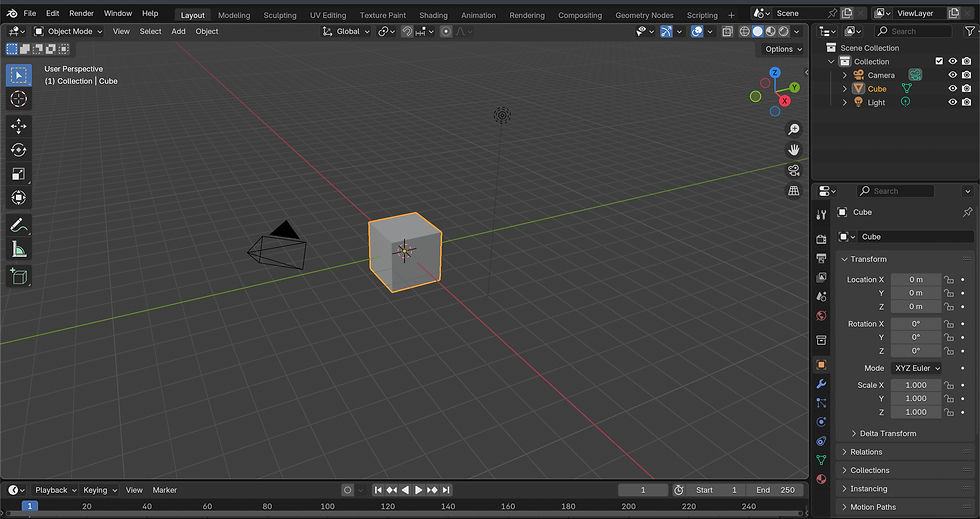Blender 3D: Innovation, Intimidation and Everything in Between
- srose804
- May 10
- 4 min read
By Shaye Rosengarden
While I am not a graphic designer, sometimes nothing can satisfy spontaneous creative urges better than hopping into programs like Adobe Illustrator or Canva to mess around with basic visual elements until a design materializes. For a self-taught graphic design amateur like me, these programs are excellent as they offer helpful blurbs about the different things you click on through the midst of a complicated UI. After a period of several months, I felt comfortable enough to post my amateurish graphics on Instagram for my show on UIC Radio. It felt incredibly rewarding to teach myself these programs and yield end products to share outward and draw attention to the radio show– so much so that I felt confident to look into other graphic design mediums. The UI of the software I had experienced left me feeling that any other program could be as easy to download and learn.
On a bit of a “graphic design is my passion” spree, I decided to download Blender 3D and attempt to create a promo for a local band called Sunshy coming on. I have always been drawn to the 3D design pipeline because it crosses with a facet of other graphic elements like animation and model texturing. 3D modeling has grown rather trendy recently, specifically those re-creating the look of late 90s and early 2000s games from the Nintendo 64 and PlayStation 2 to hop on the “Y2K aesthetic” hype train.

I won’t lie; I enjoy the look of this design style, and as someone who grew up playing video games, I knew this was the style I would try to emulate on my first go at using Blender. I would quickly realize the stark difference between the beginner-friendly features of Adobe and Canva versus the deep ocean of features embedded into Blender’s UI.
Blender is the #1 free 3D modeling software, which is also open-source and widely used among professional designers and amateurs like myself. It is incredibly accessible, but its weakness lies in the steep learning curve required to utilize its optimal performance. When the program is booted up for the first time, you are presented with a 3D view of a default cube surrounded by a perimeter of buttons and tabs for object manipulation, which is an incredibly overwhelming first impression.

Overall, the UI is organized nicely for significant features like animation, rendering, lighting and sculpting. Other seemingly simple features such as adding an image to the 3D scene background can be hidden inconveniently in menu sub-lists.
Coming from a shallow background of 3D design knowledge, I liked Blender for its large, active community of users who publish their online content, such as artwork and insanely helpful tutorials. Blender would be essentially unusable for most beginners without the abundance of handy YouTube tutorials to dig into its features. Blender’s open-source nature is another one of its strengths because it spawned a large community of add-on creators and plugins– free and paid. Finding a plugin off the internet and installing it into Blender is easy– it was the factor that allowed me to take my idea and materialize it with a free “PS2 Style” graphic plugin I found. Blender is also very friendly towards plugin usage with a modular structure allowing you to plug in effects like wires in a chain.
Getting started with a Blender project isn’t always beginner-friendly, but I found success by basing my idea on a few tutorials and using a third-party plugin. The strong user base and community that Blender has fostered play a significant role in shaping how users—especially beginners—interact with the app. Rather than having these guides imbedded in the app like Adobe, users instead have to go off on their own to find exactly what they want to create.
My first creation in Blender.
While tutorials can be a guiding light amidst Blender’s sea of features, there are many elements that seem to hold the user back. The main constraint I experienced in my attempt was the complexity of the shading and lighting features and how they connect to exporting project files. The entire screen or subject matter can disappear when there is a rendering issue, leaving the user to troubleshoot potential problems. This stunted my project and gave me a good scare, yet with some quick Google searches, I remedied the issue.
Blender could benefit from looking at what Adobe and Canva do, such as implementing basic tutorials or a guide explaining certain features. The developers would not have to cover all bases with these. Instead, basic tutorials for essential features like importing and animation would make a very efficient difference for beginners. I also feel that Blender could benefit from having a “Beginner’s Mode,” where advanced features like plugins and lighting are disabled, allowing users to focus on basic skills like modeling and animating.
Ultimately, my experience with Blender highlighted the exciting possibilities and the frustrating barriers of exploring more complex design software. While its interface lacks the hand-holding features of platforms like Adobe and Canva, the support of its online community makes it possible for beginners to power through the learning curve. Teaching myself to navigate Blender gave me a deeper appreciation for 3D design and a new outlet for creative expression, even if the process was sometimes overwhelming. With a few changes—like built-in tutorials or a simplified beginner mode—Blender could become far more approachable without sacrificing its professional power. Until then, it's a program that rewards persistence, curiosity, and the willingness to troubleshoot.
_edited.png)



Comments